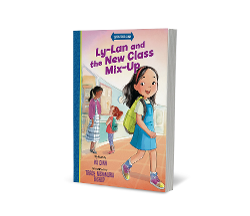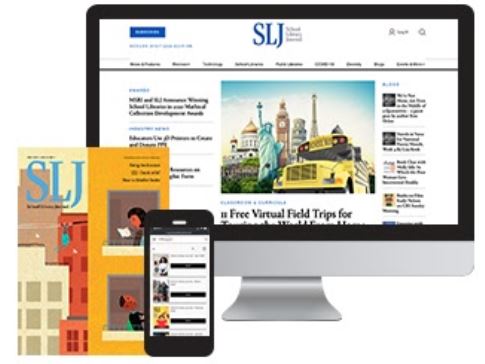Celebrating Diversity and Cultivating Empathy with Hà Dinh, Author of Ly-Lan and the New Class Mix-Up
Learn how author Hà Dinh's own experiences shaped Ly-Lan and the New Class Mix-Up, a chapter book that beautifully explores diversity, empathy, and the importance of welcoming new friends with open hearts.
 Welcome, Hà Dinh! It’s a pleasure to have you with us today to discuss your wonderful new chapter book, Ly-Lan and the New Class Mix-Up. This book touches on so many relatable themes for young readers, and one aspect that truly shines is its focus on diversity and empathy.
Welcome, Hà Dinh! It’s a pleasure to have you with us today to discuss your wonderful new chapter book, Ly-Lan and the New Class Mix-Up. This book touches on so many relatable themes for young readers, and one aspect that truly shines is its focus on diversity and empathy.
Question 1: Welcoming New Students In Ly-Lan and the New Class Mix-Up, Ly-Lan initially struggles with the idea of showing the new Vietnamese student around. This reluctance, followed by her eventual understanding and connection, offers a very authentic portrayal of a child’s journey toward empathy. What message do you hope young readers, and perhaps even school librarians, take away from Ly-Lan’s experience about welcoming new students, especially those from different backgrounds?
Thank you so much for this wonderful opportunity to share about Ly-Lan! When I was developing this series and especially this book, I wanted it to come from a place of lived experiences and authenticity. Growing up as a refugee child in Kentucky in the early 1990s, I experienced so much anxiety and stress because of the language barrier. With the help of so many caring classmates and teachers,  I slowly picked up English and learned it well enough to complete my assignments and excel in school. Later, when I became more fluent, I was asked to be the translator for new classmates from Vietnam. While I often felt conflicted about the added responsibility, the little teacher in me did enjoy helping and making new friends in the process. Ly-Lan also experiences these wide-ranging feelings from a reluctance to help to understanding the importance of her role. It also helped her to become a more empathetic individual. I hope that young readers will see and know that it’s ok to have complex and layered feelings, but they should also be open to helping others when they can. I also see librarians as champions of different languages and are often the bridge to helping those learning English become more fluent. They, too, are the helping hands to breaking the language barriers for their students.
I slowly picked up English and learned it well enough to complete my assignments and excel in school. Later, when I became more fluent, I was asked to be the translator for new classmates from Vietnam. While I often felt conflicted about the added responsibility, the little teacher in me did enjoy helping and making new friends in the process. Ly-Lan also experiences these wide-ranging feelings from a reluctance to help to understanding the importance of her role. It also helped her to become a more empathetic individual. I hope that young readers will see and know that it’s ok to have complex and layered feelings, but they should also be open to helping others when they can. I also see librarians as champions of different languages and are often the bridge to helping those learning English become more fluent. They, too, are the helping hands to breaking the language barriers for their students.
Question 2: Cultural Awareness and Representation Ly-Lan is the daughter of Vietnamese immigrants, and her heritage is subtly woven into her identity throughout the story. Why was it important for you to include this bicultural perspective, and how do you envision school librarians using Ly-Lan’s story to introduce and celebrate diverse cultural backgrounds within their libraries? Are there specific elements in the book that you hope spark conversations about Vietnamese culture, even in a small way?
It was very important to me to include both cultures and perspectives since it reflected my childhood and a blended identity that I know many of our young readers also share. I love that both her Vietnamese and American cultures are so beautifully intertwined in her world. Being both Vietnamese and American is what makes Ly-Lan so special, and I love how visible and subtle both cultures show up in her life to help celebrate her diversity, just like in the lives of many young readers who visit libraries. I hope that librarians can use Ly-Lan’s blended cultures to encourage other children to share about theirs and how they celebrate both cultures in their daily lives, especially if they are multilingual too. One element that I used to help spark further conversations is my usage of idioms and Vietnamese words in the text. I was very fascinated and intrigued by English idioms as an English Second Language student. They were one of my favorite things to learn in my English class, and I wanted to share that with my young readers. I also wanted to make Vietnamese more accessible in my stories, and therefore, I subtly added them in ways that are inviting for all and natural to the story.
Question 3: Overcoming Language Barriers and Other Differences Ly-Lan finds herself in a position where she could potentially act as a “translator” for the new student. This scenario naturally brings up the  challenges new students might face, including language barriers. From your perspective, how can Ly-Lan’s story encourage students to support classmates who might be navigating a new environment or learning English, even if they don’t share the same language or background? What do you hope Ly-Lan’s journey teaches children about connecting with others despite perceived differences?
challenges new students might face, including language barriers. From your perspective, how can Ly-Lan’s story encourage students to support classmates who might be navigating a new environment or learning English, even if they don’t share the same language or background? What do you hope Ly-Lan’s journey teaches children about connecting with others despite perceived differences?
Language barriers are difficult in the classroom, but students can work together to overcome them. While Ly-Lan was able to understand Vietnamese enough to translate, she, too, is learning both languages at the same time. This is very true for many of our young students. Understanding that we are all learning together and that each of us has strengths that can be used to help others is very empowering for students. As Ly-Lan tries to connect with her new friend from Vietnam, I hope that young readers learn to reach out to others in their classroom, school, and community and help in any way that they can too.
Question 4: Empathy in Action Beyond just understanding differences, your book really encourages active empathy. What do you believe are some practical ways school librarians can use Ly-Lan and the New Class Mix-Up to facilitate discussions about empathy and kindness, encouraging children to step into another person’s shoes?
Oftentimes, we are so focused on our own problems that we forget to think about what it’s like to be in another person’s shoes. In most of the book, Ly-Lan is so consumed with the “classroom mix-up” that it’s all she thinks and talks about while neglecting her new friend, who is struggling to find her place in school and make new friends. Once Ly-Lan realizes how much more of a friend she could be, her focus slowly shifts to her new friend and the friendship that they could have. I hope school librarians can use this to discuss further how children, using the skill set that they already have, can help other children and people in their community feel more welcomed.
Question 5: Personal Connection to the Theme As a Vietnamese American author, how much of your own experiences or observations influenced the themes of cultural awareness and welcoming newcomers in Ly-Lan’s story? Did you draw from any personal moments in crafting these specific elements of the narrative?
 Since so much of my writing and work is based on my own experiences, I really wanted the readers to truly experience and be immersed in Ly-Lan’s journey, no matter if she is at school or at home. My goal was to help the readers get a front-row seat into the life of a Vietnamese American girl and what makes her special, flaws and all. Beyond the beautiful, blended cultures that make Ly-Lan unique, she is also determined, creative, spirited, kindhearted, and empathetic. She is like any eight-year-old girl who is trying her best to navigate through third grade with her friends, family, and faith.
Since so much of my writing and work is based on my own experiences, I really wanted the readers to truly experience and be immersed in Ly-Lan’s journey, no matter if she is at school or at home. My goal was to help the readers get a front-row seat into the life of a Vietnamese American girl and what makes her special, flaws and all. Beyond the beautiful, blended cultures that make Ly-Lan unique, she is also determined, creative, spirited, kindhearted, and empathetic. She is like any eight-year-old girl who is trying her best to navigate through third grade with her friends, family, and faith.
Thank you so much again for having me! I can’t wait for Ly-Lan and the Unfair Book Fair to come out in January 2026 and Ly-Lan and the Missing Tooth Fairy in June 2026!
SPONSORED BY
RELATED
The job outlook in 2030: Librarians will be in demand
The job outlook in 2030: Librarians will be in demand
ALREADY A SUBSCRIBER? LOG IN
We are currently offering this content for free. Sign up now to activate your personal profile, where you can save articles for future viewing








Add Comment :-
Be the first reader to comment.
Comment Policy:
Comment should not be empty !!!